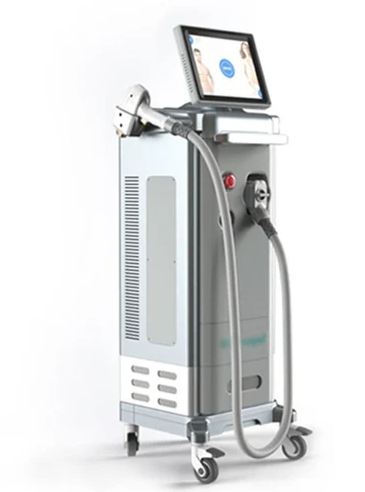Laser hair removal has become a popular and effective solution for long-term hair reduction. For clinics looking to invest in a laser hair removal machine, the decision can be overwhelming given the variety of options available. This guide will break down the key factors to consider, the types of machines available, and tips for making the right choice for your clinic.
Understanding Laser Hair Removal
Laser hair removal works by using concentrated light to target the melanin in hair follicles. The light energy is absorbed, resulting in the destruction of the hair follicle and inhibiting future hair growth. The effectiveness of the treatment depends on several factors, including skin type, hair color, and the technology used in the machine.
Key Factors to Consider When Choosing a Laser Hair Removal Machine
1. Type of Laser Technology
- Alexandrite Laser: Best for light to olive skin tones; offers fast treatment times and is effective on fine to medium hair.
- Diode Laser: Suitable for a wider range of skin types, including darker skin. It penetrates deeper, making it effective for various hair types.
- Nd:YAG Laser: Ideal for darker skin tones. It has a longer wavelength, reducing the risk of skin damage.
- Ruby Laser: Less commonly used, but effective for lighter skin types. It can target fine hair effectively.
2. Wavelength Considerations
- Shorter Wavelengths: Effective for lighter skin and finer hair but can be more painful.
- Longer Wavelengths: Better for darker skin tones, as they penetrate deeper and are less likely to cause damage to the epidermis.
3. Cooling Technology
- Integrated Cooling Systems: Machines with built-in cooling can enhance patient comfort and reduce the risk of burns.
- Cryogen Spray or Contact Cooling: Additional cooling methods that can help manage pain during treatment.
4. Treatment Speed and Efficiency
- Spot Size: Larger spot sizes allow for quicker treatments, making them more efficient for larger areas.
- Pulse Duration: Shorter pulse durations can reduce treatment time while ensuring effective hair removal.
5. Safety Features
- Skin Type Assessment: Machines that include skin tone analysis can help customize treatments and enhance safety.
- Emergency Shut-Off: Essential safety feature to prevent accidents during operation.
6. Ease of Use
- User-Friendly Interface: An intuitive interface can streamline the treatment process and reduce training time for staff.
- Portability: Consider the size and weight of the machine, especially if your clinic has limited space.
7. Maintenance and Service Requirements
- Regular Maintenance: Inquire about the maintenance schedule and costs associated with the machine.
- Technical Support: Ensure that the manufacturer offers reliable technical support for troubleshooting and repairs.
8. Cost and Budget Considerations
- Initial Investment: Evaluate the upfront cost of the machine and ensure it fits within your budget.
- Operating Costs: Consider the costs associated with consumables, maintenance, and training.
9. Training and Certification
- Staff Training: Check if the manufacturer provides training for your staff on how to use the machine effectively and safely.
- Certification Programs: Some machines may require operators to be certified to comply with local regulations.
Types of Laser Hair Removal Machines
1. Standalone Machines
- Description: These are dedicated laser systems designed solely for hair removal.
- Pros: Typically offer advanced features and better performance.
- Cons: Higher initial investment.
2. Multi-Functional Machines
- Description: These machines can perform various treatments, such as skin rejuvenation and tattoo removal, in addition to hair removal.
- Pros: Versatile and can attract a broader clientele.
- Cons: May not be as specialized for hair removal as standalone machines.
3. Portable Devices
- Description: Smaller, portable machines ideal for clinics with limited space or for mobile services.
- Pros: Easy to transport and store.
- Cons: May have limitations in terms of power and efficiency.
Additional Considerations
1. Patient Demographics
- Target Audience: Understand the demographics of your clients to choose a machine that meets their needs, including skin types and hair characteristics.
- Market Trends: Stay informed about trends in hair removal to ensure your clinic remains competitive.
2. Regulatory Compliance
- Local Regulations: Ensure the machine complies with health and safety regulations specific to your area.
- Licensing: Verify that your clinic has the necessary licenses to operate laser hair removal equipment.
3. Patient Reviews and Feedback
- Testimonials: Gather feedback from current users of the machine to understand its effectiveness and reliability.
- Clinical Results: Look for evidence of clinical studies supporting the machine’s efficacy.
Conclusion
Choosing the right laser hair removal machine for your clinic is a crucial decision that can impact both patient satisfaction and your clinic’s success. By considering factors such as laser technology, safety features, ease of use, and maintenance requirements, you can make an informed choice that meets the needs of your clientele. Whether you opt for a standalone device or a multi-functional machine, conducting thorough research and understanding your clinic's specific needs will ensure you invest wisely and provide effective hair removal solutions. Embrace the opportunity to enhance your services and grow your practice with the right equipment.





Comments